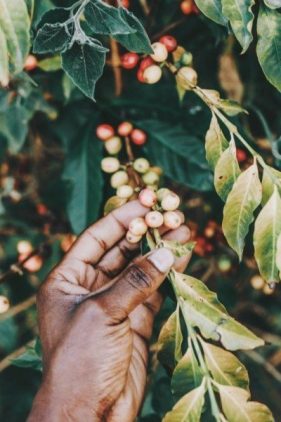
Robusta coffee is a type of coffee made from the beans of the Coffea canephora plant. Robusta originated in Central and Western sub-Saharan Africa. It is the second most popular coffee in the world, making up 40% of the worlds coffee production. It comes second only to Arabica which makes up the remaining 60% of coffee production worldwide.
Robusta can grow in low altitudes, as well as diverse climatic conditions. Farmers love to grow it because it grows faster, and is more disease and pest-resistant than Arabica coffee. The robusta beans are associated with producing coffee that is very bitter and has a low acidic rate. As a result of their high bitterness level the coffee beans cannot be used in every brew. The robusta beans are primarily used for espresso or as a filler for lower-grade ground coffee blends as they produce a strong flavour of coffee.
A study in 2018 found that Coffea arabica is a more effective cognition enhancer, having intact polysaccharides, sugars (glucose), amino acids and chlorogenic acids, while it burns in robusta due to excessive roasting.
WHERE AND HOW DOES THE ROBUSTA COFFEE TREE GROW?
In a ‘closed’ environment such as a rainforest, nutrients are recycled on their own and plants are more or less self-sufficient. However, where plants are grown in a commercial environment like coffee growing, it is necessary to replenish the nutrients that are removed from the system through the harvested crop. Without additional nutrients in some form of fertilizer, coffee yields will continue to decline as nutrients are removed through the harvested coffee beans. For sustained productivity, coffee requires a high level of fertility and an intensive fertilizer program is therefore essential.
The coffee tree requires certain elements in large quantities such as nitrogen, phosphorus and potassium and these occur in many chemical forms. These elements are referred to as macronutrients.
Nitrogen is necessary for vegetative growth. It increases tree-bearing capacity and enhances coffee bean size.
Phosphorus is necessary for root development, promotion of early berry maturity and increases bean density.
Potassium is necessary for berry development and ripening, enhanced mucilage formation, promotion of healing injured tissue especially after picking, pruning and hailstorm damage and regulation of water uptake from the soil.
Some micronutrients that coffee plant needs are: Zinc, Copper, Magnesium, Calcium, Boron, Iron, Manganese, Molybdenum, Sulphur and Chlorine.
Continuous soil management for high levels of fertility is key to grow even bigger quantities of coffee beans.
Used materials:
https://enjoyjava.com/robusta-coffee/
https://www.who.int/dietphysicalactivity/media/en/gsfao_cmo_049.pdf?ua=1
https://www.healthbenefitstimes.com/robusta-coffee/
https://ugandacoffee.go.ug/sites/default/files/Resource_center/Robusta%20Coffee%20Handbook.pdf
